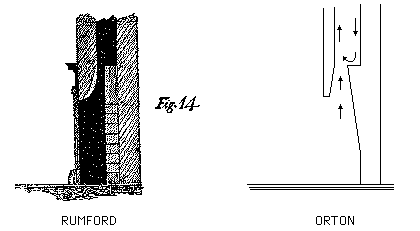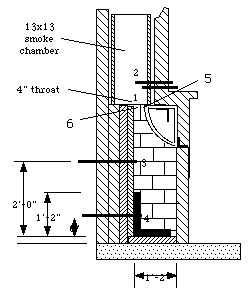|
Buckley Rumford Company RUMFORD... The Fireplace That's More Like It Used To Be Than Ever Before by Jim Buckley |

|
|
Rumford fireplaces are more popular now than at any time since 1850. The traditionally tall Rumfords look appropriate in today's popular, classically designed homes with tall ceilings. The legendary heating efficiency of the Rumford is attractive to those who are building energy efficient homes and are concerned about air quality. Building codes across the country have been changed, where necessary, to permit the tall and shallow Rumford fireplaces. The biggest clay flue liner company in the country, Superior Clay Corporation, in Uhrichsville, Ohio, is manufacturing Rumford fireplace components and marketing them through masonry building materials dealers nationally. A California brick manufacturer, McNear Brick, is testing Rumford fireplaces for heating efficiency and emissions in a test lab set up by Dr. Dennis Jaasma of the Virginia Politechnical Institute. Rumfords used to be very popular in this country when people heated their homes with fireplaces. Thomas Jefferson built Rumfords at Monticello, and George Renick (who introduced shorthorn cattle to Ohio in the 1790s, creating Route 22 in the process) built them in Chillicothe, Ohio. By 1854 Henry David Thoreau, in Walden, listed Rumford fireplaces along with plaster walls and Venetian blinds among the comforts taken for granted by civilized man. By mid-century everyone had Rumfords and the word "Rumford" was synonymous with "fireplace." Trouble was not all Rumfords were equal. There were variations and interpretations of what constituted a Rumford fireplace right from the beginning. Jefferson wrote a couple of letters and made some drawings in an effort to improve the Rumford design, but he didn't seem to understand streamlining (or "pneumatics" as Rumford would have put it) and neglected to round the breast. Commanding all the logic of the blind men in the Indian folk tale describing an elephant, Thomas Danforth introduced the erroneous idea that the "smoke shelf" blocked down drafts in the back of the chimney, in his essay "fully explaining" Rumford published in 1796. James Meese, editor of the influential 1804 Domestic Encyclopedia, took it upon himself to interpret Rumford, weaving in much incorrect information of his own about radiation. Others, like Gillespie in 1904, sought to improve upon Rumford or take the best of Rumford for their own profit and in so doing intentionally misrepresented Rumford. The most popular book on Rumford fireplaces this century, Vrest Orton's The Forgotten Art of Building a Good Fireplace, now in its 23rd edition, was where many of us first heard about Rumford. Orton, however, picks up and repeats many of these 18th and 19th century myths and misinterpretations.

Fortunately, Rumford's essays on fireplaces, although out of print, are still readily available in libraries. The easiest to get is in The Collected Works of Count Rumford; Sanborn Brown, ed.; Harvard Press; 1969; vol. 2.This century more ordinary people are familiar with radiation and fluid dynamics than even very well educated people like Thomas Jefferson and James Meese were two hundred years ago. The result is that Rumford fireplaces are being built with straight backs and rounded breasts. Rumford fireplaces are more like they used to be than ever before. Count Rumford, for whom the fireplace is named, was born Benjamin Thompson in Woburn, Massachusetts in 1753 and, because he was a loyalist, he left (abruptly) with the British in 1776. He spent much of his life as an employee of the Bavarian government where he received his title, "Count of the Holy Roman Empire." Rumford is known primarily for the work he did on the nature of heat. Back in England, Rumford applied his knowledge of heat to the improvement of fireplaces. He made them smaller and shallower with widely angled covings so they would radiate better. And he streamlined the throat, or in his words "rounded off the breast" so as to "remove those local hindrances which forcibly prevent the smoke from following its natural tendency to go up the chimney..." Rumford wrote two essays detailing his improvements on fireplaces in 1796 and in 1798. He was well known and widely read in his lifetime, and almost immediately in the 1790s his "Rumford fireplace" became state of the art worldwide.
Why Rumford Fireplaces WorkRumford understood that the only useful heat generated by a fireplace was radiant heat. The air that the fire heated was mixed with smoke and went up the chimney. So he made a fireplace that had a big, tall and wide opening and was very shallow with widely splayed covings or jambs to reflect as much radiant heat out into the room as possible. Rumford wanted to "reflect" the heat directly out into the room. He saw no advantage of absorbing the heat and re-reflecting it. Heating up the firebox only served to heat the air that came into contact with it which just was lost up the chimney. He advocated plastering and whitewashing the firebox to keep it clean and reflective. He was vehemently opposed to cast iron firebacks because they only absorbed the radiant heat and got hot which in turn heated the air which was mixed with the smoke and was lost up the chimney. Modern physicists, familiar with Planck's Law, argue that what really happens is that the firebox, whether it's whitewashed or not, does absorb heat and re-radiates it out into the room. There isn't a significant difference between whitewashed plaster and soot-covered brick, they say, in the infrared range. Both are pretty good "black body radiators." Whatever. The objective remains to reflect or re-radiate as much heat out of the face of the fireplace as possible. It doesn't hurt to whitewash the firebox or to insulate behind the firebrick. It does hurt to cover the opening with glass doors, which cut about 80% of the infrared radiation. Tall, wide shallow fireplaces tend to smoke. The other half of Rumford's genius is his intuitive understanding of fluid dynamics - way ahead of his time. By rounding the breast to "remove those local hindrances which forcibly prevent the smoke from following its natural tendency to go up the chimney..." he essentially created a venturi, a nozzle, like an inverted carburetor, that shot the smoke and air up through the throat into the receiving smoke chamber. Rumford may not have known how ingenious his "rounded breast" really was. In our testing at McNear Brick we built a Rumford fireplace studded with thermocouples just to see what the temperatures were at various places. We wanted to see if the flow through the throat was laminar, so we placed two thermocouples at the narrowest part of the throat, one near the curved breast (5) and one a couple on inches farther back near the fireback (6). To our amazement, with an established 1700 degree F fire, we recorded only 75 degrees F near the rounded throat at 5, and, only two inches away near the back at 6, we recorded 730 degrees! The flow through the throat certainly is laminar. The room air coming in over the fire doesn't mix with the hot products of combustion, but goes up with them through the throat. It's like a sheet of clean room air that acts like an invisible glass door to keep the smoke behind it as they both go up through the throat together.
 Most masons, used to building modern fireplaces, have trouble believing a Rumford will draw until they see it happen. The rules are different. In a modern fireplace the fireback is usually sloped or rolled forward casting the products of combustion forward. The incoming room air spills over the sharp edge of a steel lintel and mixes turbulently with the smoke. Most masons will tell you that you need to "cross over" or drop the lintel about eight or nine inches below the damper to create a pocket for this smoke and in-coming room air to "roll" or the fireplace will smoke.
 Rumford devoted Chapter II of his 1796 essay on fireplaces to "Practical Directions designed for the Use of Workmen, showing how they are to proceed in making the Alterations necessary to improve Chimney Fire-places, and effectually to cure smoking Chimneys." Essentially, it's laborious and anyone can read it for themselves. Rumford apologizes to his readers "for having been so very particular in these descriptions and explanations, but it must be remembered that this chapter is written principally for the information of those who had few opportunities of employing their attention in abstruse philosophical researches..." Suffice it to say Rumford's method is to get the basic shape right, with a plumb bob and a special device he suggests for marking out the 135 degree angle for the covings. His masons built with brick or stone and plastered the surfaces to make a clean reflective surface and used plaster to round off the breast. Because Superior Clay Corp. has been so successful in manufacturing vitrified clay Rumford throats and smoke chambers I think one of the footnotes in Rumford's 1796 essay is especially interesting:
"I have of late been much engaged in these investigations, and am now actually employed daily in making a variety of experiments with grates and fireplaces, upon different constructions, in the room I inhabit in the Royal Hotel in Pall Mall; and Mr. Hopkins, of Greek Street, Soho, Ironmonger to his Majesty, and Mrs. Hempel, at her Pottery at Chelsea, are both at work in their different lines of business, under my direction, in the construction of fireplaces upon a principle entirely new, and which, I flatter myself, will be found to be not only elegant and convenient, but very economical. But as I mean soon to publish a particular account of these fireplaces, with drawings and ample directions for constructing them, I shall not enlarge further on the subject in this place."Rumford never did publish the results of these experiments. Even though he wrote another essay on fireplaces two years later, in 1798, and had the opportunity to discuss these experiments in his essay on Kitchen Fireplaces, he never did. From the difficulty Superior Clay had in manufacturing a big Rumford throat that wouldn't warp or crack in the drying and firing process, I suspect Rumford's potter was unsuccessful. Our "potter," the Superior Clay Corp., may have only just accomplished what Rumford envisioned two hundred years ago. ________ An edited version of this article was originally published in the March, 1994 issue of the Journal of Light Construction.
|

Reader Comments
Rumford's Essays: Chimney Fireplaces, 1796 & Supplemental Observations, 1798
More About Count Rumford
About Jim Buckley
Buckley Rumford Fireplaces
Copyright 1995 - 2017 Jim Buckley
All rights reserved.
webmaster